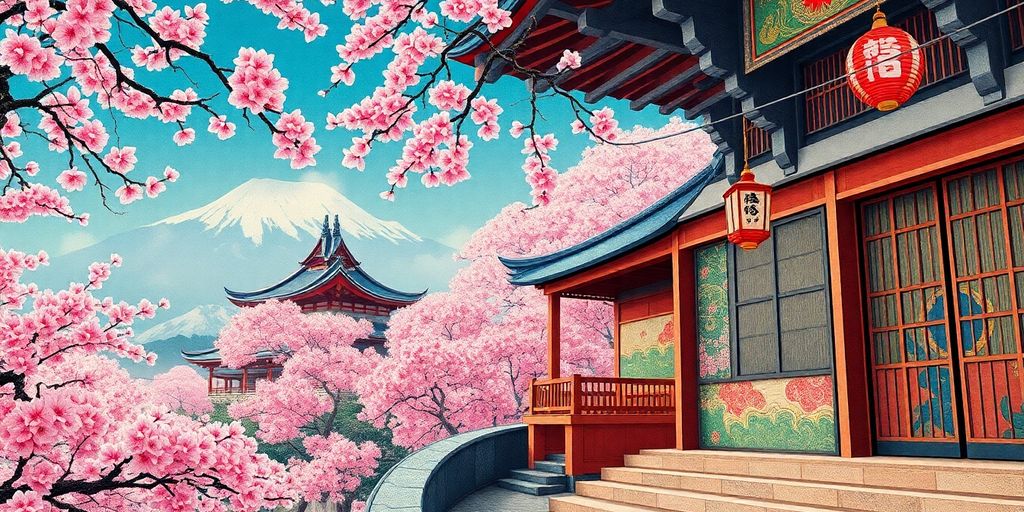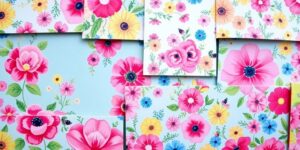Japanese art is a captivating blend of old and new, where ancient techniques meet modern creativity. This article takes you on a journey through various aspects of Japanese art, from the fusion of traditional crafts with contemporary styles to the mesmerizing influence of nature and folklore. Whether it’s the elegance of cherry blossoms or the storytelling through visual art, Japanese art offers a unique perspective that continues to inspire artists around the world.
Key Takeaways
- Japanese art beautifully combines traditional and modern elements, creating unique and visually stunning pieces.
- Nature plays a significant role in Japanese art, influencing everything from landscape paintings to seasonal themes.
- Innovative techniques, like the use of rice paper and watercolor, showcase the adaptability and creativity of Japanese artists.
- Cherry blossoms are not just a popular motif but also a symbol of cultural significance and seasonal celebration in Japan.
- Folktales and cultural heritage are deeply embedded in Japanese art, offering rich storytelling through visual media.
The Fusion Of Traditional And Contemporary Japanese Art
Exploring Hidenobu Suzuki’s Photography
When you think of Hidenobu Suzuki’s work, it’s all about capturing the essence of everyday Japanese life. His photos are like a visual diary, showing the charm of simple moments. The magic lies in how Suzuki’s images bring out the beauty in the ordinary. Now, imagine these stunning shots printed on traditional Kyoto folding fans. It’s like marrying two worlds—old-school craftsmanship meets modern art. The fans’ intricate folds and Suzuki’s vibrant photos create a mesmerizing blend that screams both tradition and innovation.
The Art Of Kyoto Folding Fans
Kyoto folding fans are not just about keeping cool; they’re a piece of history. These fans have been around for about 300 years, crafted with meticulous care. Their design is a nod to the concept of “Wabi-sabi,” finding beauty in imperfection. By adding contemporary art, like Suzuki’s photography, these fans become a canvas that tells a story. They bridge the gap between the old and the new, showing how traditional art forms can evolve without losing their roots.
Cultural Significance Of Fan Art
Fan art in Japan is more than just decoration. It’s a symbol of cultural identity and heritage. Fans have been used in ceremonies, dances, and even as a means of communication. The art on these fans often reflects themes like “Kintsugi,” the art of repairing with gold, symbolizing resilience and beauty in mending. Today, by incorporating contemporary elements, fan art continues to be a living tradition, adapting yet preserving its cultural significance. This fusion of traditional and modern art forms not only keeps the craft alive but also makes it accessible to new generations.
Captivating Japanese Landscape Paintings
The Beauty Of Shirakawa-go
Tucked away in the mountains of Gifu Prefecture, Shirakawa-go is a village that seems to leap straight out of a fairy tale. Known for its traditional gassho-zukuri farmhouses, the village is a living museum of Japan’s rural past. The intricate architecture of these wooden houses, with steep thatched roofs, is not only visually striking but also functional, designed to withstand heavy snowfalls. Silk paintings often capture the essence of Shirakawa-go, highlighting its serene beauty against the backdrop of lush greenery or a blanket of snow.
Takayama’s Unique Horticultural Techniques
Takayama, another gem in Gifu, is famous for its unique horticultural technique called yukitsuri, or “snow hanging.” This method involves suspending ropes from tall poles to support tree branches during heavy snowfalls. It’s a practical solution that doubles as an art form, transforming the landscape into a scene from a brush painting. Visitors during the winter months can witness this captivating blend of nature and human ingenuity.
The Influence Of Nature On Japanese Art
Nature has always played a pivotal role in Japanese art, serving as a constant source of inspiration for artists. From the delicate brushstrokes in traditional paintings to the serene landscapes depicted in modern works, the natural world is a recurring theme. Artists often use materials like rice paper to create textured landscapes that evoke the gentle sway of bamboo or the stillness of a pond. Entrancing Landscapes: In Search of Modern Japanese Painting is a perfect example of how these themes continue to evolve, showcasing the Umi-Mori Art Museum’s collection that highlights the evolution and significance of modern Japanese painting.
Japanese landscape paintings are not just about capturing a scene; they are about conveying a feeling, an essence of a place that resonates with tranquility and beauty. Whether through the meticulous details of silk paintings or the fluidity of brush painting, these artworks invite viewers to pause and appreciate the harmony between humans and nature.
Innovative Techniques In Japanese Art

The Use Of Rice Paper In Modern Art
Rice paper, a staple in traditional Japanese art, has found its way into modern artistic expressions. Artists today use it not just for its traditional applications but also to create textures and layers that bring depth to their work. This material, often mistaken for being made from rice, is actually crafted from the fibers of mulberry trees, offering a unique blend of durability and delicacy. In modern Japanese art, rice paper is used in various art forms such as calligraphy, watercolor, and even mixed media projects, showcasing its versatility.
Combining Traditional Crafts With New Media
Japanese art has always been about balance, and this is evident in how traditional crafts like woodblock prints are being combined with new media. Artists are now blending age-old techniques with digital tools to create artworks that resonate with both the past and the present. This fusion is not just a celebration of heritage but also a step towards innovation. For instance, digital platforms now allow artists to experiment with traditional forms like pottery and ceramic art, bringing them to new audiences and spaces.
The Role Of Watercolor In Japanese Art
Watercolor painting, deeply rooted in Japanese culture, continues to evolve with contemporary practices. This medium is cherished for its ability to capture the subtle nuances of nature, a central theme in Zen art. Modern Japanese artists are pushing the boundaries of watercolor, using it to explore themes beyond the traditional landscapes and nature scenes. This evolution is evident in workshops and tutorials that teach both traditional techniques and modern innovations, making Japanese art painting tutorials a valuable resource for artists worldwide.
Japanese art is a living, breathing testament to the country’s rich cultural tapestry. By embracing both old and new, it continues to inspire and mesmerize art enthusiasts everywhere.
The Allure Of Cherry Blossom Art

Symbolism Of Sakura In Japanese Culture
Cherry blossoms, or sakura, are more than just flowers in Japan; they’re a symbol of the fleeting nature of life. The blossoms’ short-lived beauty is a reminder that life is precious and should be cherished. People gather under sakura trees for hanami, or flower-viewing parties, celebrating the arrival of spring. This tradition is deeply rooted in Japanese culture, reflecting the appreciation for nature’s transient beauty.
Artistic Representations Of Cherry Blossoms
Artists have long been captivated by the delicate beauty of cherry blossoms. From traditional paintings to modern photography, sakura have been depicted in countless ways. These artworks not only capture the visual appeal of the blossoms but also evoke the emotions they inspire. In fact, the Japanese Cherry Blossom art piece by Deborah Pendell is a stunning example of how these flowers continue to inspire artists across the globe.
Seasonal Celebrations Through Art
Cherry blossoms herald the start of spring in Japan, and their arrival is celebrated with festivals and art. Cities across the country host events where people can enjoy the blossoms alongside cultural performances and exhibitions. These celebrations often feature cherry blossom-themed artworks, from paintings to crafts, showcasing the creative ways artists interpret this seasonal wonder. Such events highlight the integral role sakura play in both cultural and artistic expressions, making them a beloved symbol of renewal and beauty.
The Impact Of Japanese Folktales On Art

Storytelling Through Visual Art
Japanese folktales have long been a wellspring of creativity for artists. These stories, with their rich characters and moral lessons, are often brought to life through various art forms. Whether it’s a painting, sculpture, or an intricate print, the essence of these tales is captured visually. Artists often use traditional techniques to depict scenes from these stories, blending them with modern styles to create something truly unique. By doing so, they not only preserve the tales but also introduce them to new audiences.
Folktales As Inspiration For Artists
Many contemporary artists find inspiration in the mystical and often whimsical elements of Japanese folklore. Characters like the Yokai, supernatural beings from these tales, are depicted in countless artworks. These beings, with their mysterious and sometimes mischievous nature, offer a fascinating subject for artists to explore. By reimagining these folktales, artists can express their own interpretations and bring a fresh perspective to age-old stories.
Cultural Heritage Reflected In Art
Art inspired by Japanese folktales often serves as a mirror reflecting cultural heritage. These works are not just about storytelling; they are about preserving the values and traditions that have been passed down through generations. By incorporating elements of these tales into their art, artists help keep cultural narratives alive. This connection to the past is vital, as it offers insight into the beliefs and values that have shaped Japanese society over the centuries.
Japanese folktales are more than just stories; they are a bridge between the past and present, offering a glimpse into the cultural soul of Japan. Through art, these tales continue to inspire and resonate, ensuring their legacy endures.
The Evolution Of Japanese Art Forms

From Edo Period To Modern Day
Japanese art has undergone significant transformations, especially from the Edo period to today. The Edo period, spanning from 1603 to 1868, was a time when art flourished under the Tokugawa shogunate. Ukiyo-e, a genre of woodblock prints and paintings, captured everyday life, landscapes, and the vibrant world of kabuki theater. Fast forward to the present, and you see a fascinating blend of these traditional elements with contemporary styles. Modern Japanese artists are not just preserving ancient techniques but also pushing boundaries by integrating new media and technology.
The Global Influence Of Japanese Art
Japanese art has left a lasting impression worldwide. From the minimalist aesthetics of Zen gardens to the intricate designs of kimono fabrics, the influence is evident. Western artists, particularly during the Impressionist movement, were captivated by Japanese techniques and perspectives. This cross-cultural exchange continues today, with anime and manga becoming global phenomena, influencing storytelling and visual arts across the globe.
Preserving Traditional Techniques In Contemporary Art
In today’s fast-paced world, there’s a growing movement to keep traditional Japanese art forms alive. Crafts such as the tea ceremony art, calligraphy, and pottery are being taught to younger generations, ensuring these skills are not lost. Artists are also finding innovative ways to incorporate these techniques into modern works, creating a unique fusion that respects the past while embracing the future.
The journey of Japanese art is a testament to its resilience and adaptability, reflecting a culture that honors its history while continuously evolving. Through the ages, these art forms have not only survived but thrived, becoming an integral part of Japan’s cultural identity.
Wrapping Up the Wonders of Japanese Art
So, there you have it. Japanese art is like this endless treasure chest, full of surprises and beauty. From the way they blend old traditions with new ideas, to the simple yet profound moments captured in everyday life, it’s all pretty mind-blowing. Whether it’s the intricate designs of a Kyoto fan or the serene landscapes of a watercolor painting, there’s something about Japanese art that just pulls you in. It’s not just about looking at something pretty; it’s about feeling a connection to a culture that’s both ancient and modern. So next time you see a piece of Japanese art, take a moment to really look at it. You might just find yourself mesmerized.
Frequently Asked Questions
What makes Hidenobu Suzuki’s photography special?
Hidenobu Suzuki’s photos capture the beauty of everyday life in Japan, highlighting simple moments and the unique charm of Japanese culture.
How are traditional Kyoto fans made?
Traditional Kyoto fans are crafted with intricate folding designs and are often decorated with rich colors and textures, making them both beautiful and culturally important.
What is the cultural significance of fan art in Japan?
Fan art in Japan is not only a traditional craft but also a medium that blends historical significance with modern artistic expression.
Why is Shirakawa-go famous in Japanese art?
Shirakawa-go is celebrated for its picturesque landscapes, which inspire artists to capture its unique beauty in various forms of art.
What is yukitsuri in Japanese horticulture?
Yukitsuri is a technique used to protect tree branches from heavy snow by supporting them with ropes, creating a unique artistic appearance.
How do Japanese folktales influence art?
Japanese folktales often serve as inspiration for artists, providing rich stories and cultural heritage that are reflected in visual art.



